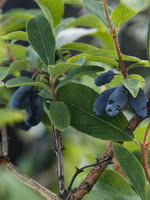Mon-Fri 9am - 5pm Mountain time
Kawai Haskap (Honeyberry) vs Bilberry
Vaccinium myrtillus
Lonicera caerulea Kawai
CUSTOM GROW
NOT AVAILABLE THIS SEASON - MIGHT RETURN
Bilberry is a native perennial shrub valued for its small, blue-black berries that ripen in mid to late summer. The berries resemble blueberries but have a richer, more tart, and intense flavor. They have long been used for fresh eating, baking, and preserves, while also providing food for birds and mammals. In spring, its delicate pinkish flowers attract bees and other pollinators.
Growing low to the ground, Bilberry forms spreading colonies that create dense understory cover. This growth habit provides food and shelter for wildlife, and its foliage adds seasonal interest by turning red to purple in autumn. With its adaptability and ecological benefits, Bilberry is well-suited for naturalization, ecological restoration, and pollinator gardens.
The Kawai Haskap is a compact fruit-bearing shrub that blooms with small white flowers in early spring and then fruits with medium-sized, oval shaped berries in late June and July. Their taste is usually described as something between a raspberry and a blueberry. The berries are blue and sweet and are great for fresh eating or preserves.
The Kawai Haskap, or Kawai Honeyberry is cold-hardy and is suitable for urban gardens.
Kawai is a late pollinating variety. Pair with other late pollinators to have a higher yield.
Giants Heart Haskap is a great companion variety for the Kawaii.
Bilberry Quick Facts
Kawai Haskap (Honeyberry) Quick Facts
Toxicity: leaves may be unsafe in high doses

